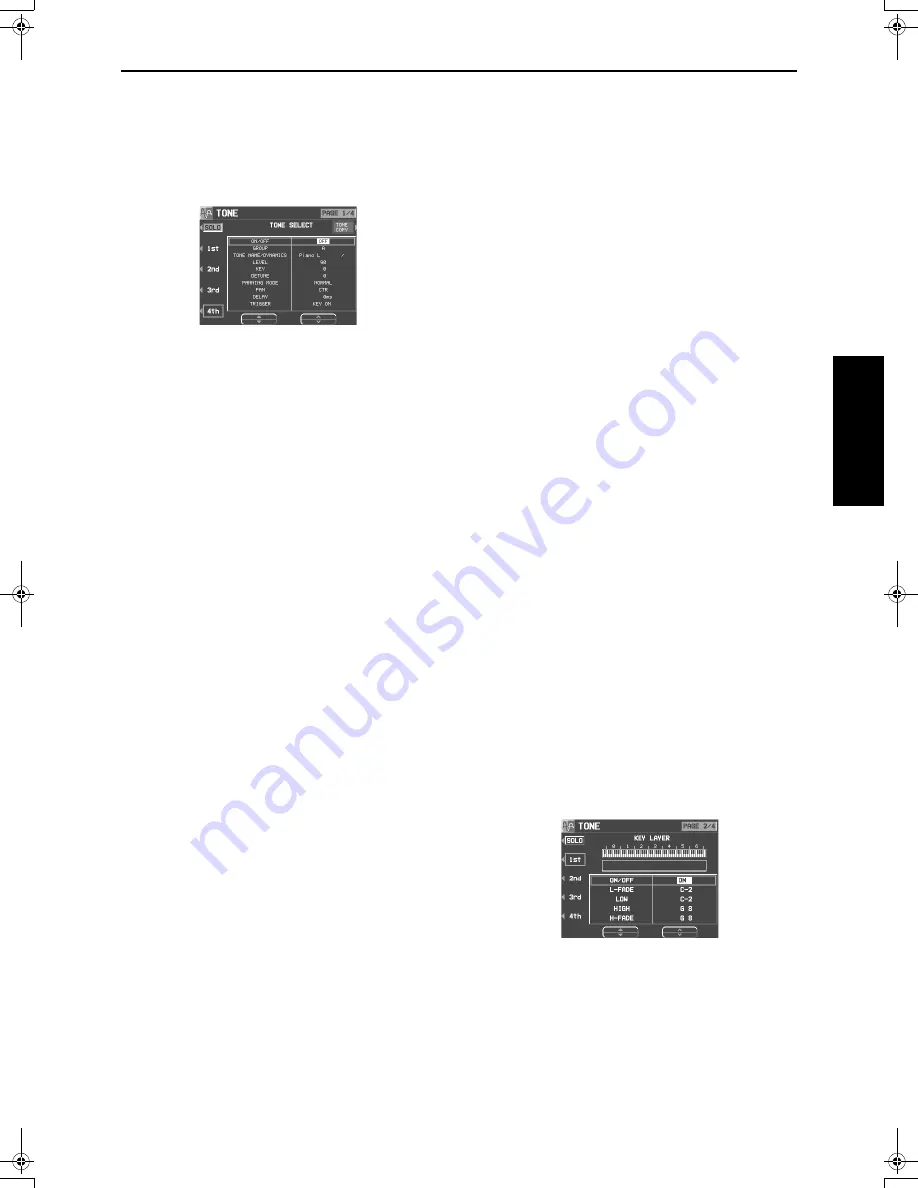
Part VIII
Sound Edit
111
QQTG0701
So
un
d E
d
it
TONE SELECT
1.
On the SOUND EDIT menu, select TONE.
• The display looks similar to the following.
• Use the
▲
and
▼
buttons to select a setting item and
then the
∧
and
∨
buttons to specify a selection.
• Select ON/OFF and use the
∧
and
∨
buttons to select
ON or OFF.
2.
Use the buttons to the left of the display to
select the tone you wish to edit (1st, 2nd, 3rd,
4th).
3.
Select a sound for the tone.
• Select GROUP and use the
∧
and
∨
buttons to select
the group, and select TONE NAME and use the
∧
and
∨
buttons to select the sound.
• A “
∗
” mark in the DYNAMICS column indicates that a
TONE DYNAMICS change was made to the sound.
4.
Select LEVEL and use the
∧
and
∨
buttons to
adjust the volume.
5.
Select KEY and use the
∧
and
∨
buttons to set
the pitch of the output sound.
6.
Select DETUNE and use the
∧
and
∨
buttons
for fine adjustment of the pitch deviation.
7.
Select PANNING MODE and use the
∧
and
∨
buttons to select mode. (NORMAL, RANDOM,
STEREO R, STEREO L)
• If RANDOM, STEREO R or STEREO L is selected for the
MODE, the balance is fixed (cannot be moved).
8.
Select PAN and use the
∧
and
∨
buttons to
adjust the stereo balance.
• CTR is the center point. At L64, the sound is all the way
to the left, at R63 all the way to the right.
9.
Select DELAY and use the
∧
and
∨
buttons to
adjust the delay time of the sound.
• The higher the number, the longer the delay before
sound output.
10.
Select TRIGGER and use the
∧
and
∨
but-
tons to select a trigger mode.
KEY ON:
The normal mode, in which sound is emitted
when the key is played.
KEY OFF:
Sound is emitted when the key is released
(like muted strings, for example).
LEGATO:
Sound is emitted only when the key is played
legato.
NON LEG:
Sound is not emitted when the key is played
legato.
PEDAL:
The sound is produced only while the
SUS-
TAIN
button is on.
CHORD:
The sound is emphasized when chords are
played (like the cutting sound of a guitar, for
example).
䡲䡲䡲䡲
TONE COPY
You can copy the tone of a particular sound to a
specified tone in the sound you are editing.
1.
On the 1/4 display, press the TONE COPY
button.
2.
Use the FROM
∧
and
∨
buttons to select the
tone to copy from.
• Use the OPTION
∧
and
∨
buttons to select the item you
wish to copy.
3.
Use the TO
∧
and
∨
buttons to select the tone
you wish to copy to.
4.
Press the OK button.
• Tone copy is executed.
KEY LAYER
Adjust the relation of tone output to keyboard
location.
1.
Use the
PAGE
buttons to view the 2/4 display.
• The display looks similar to the following.
• Use the
▲
and
▼
buttons to select a setting item and
then the
∧
and
∨
buttons to specify a selection.
2.
Use the buttons to the left of the display to
select a tone (1st, 2nd, 3rd or 4th).
3.
Select L-FADE and use the
∧
and
∨
buttons
and select LOW and use the
∧
and
∨
buttons
to define the area of the lower range of tone
output.
• By entering different values for the L-FADE and LOW set-
tings, you can define a sloping volume increase to the
peak output volume which corresponds to the note pitch.
13_Part VIII.fm 111 ページ 2003年5月20日 火曜日 午前8時21分
Summary of Contents for SX-PR54
Page 4: ...4 QQTG0701 ...
Page 5: ...5 QQTG0701 ...






























